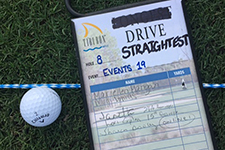HOLE 5:
SCORE CARD BASICS
To score or not to score? That is a very good question! For most beginners, getting the ball airborne and heading towards the hole is enough of a challenge - never mind counting the strokes to get there. At this stage, we recommend that you choose other ways to keep score. Many charity tournaments and business outings are set up as a team format, which takes the focus off playing your own ball. For social settings, we have developed the "Play Your Own Way" concept, which allows you to create your own rules so you can keep up with experienced players. As you begin to improve, you may decide to keep score in the traditional manner, but know that it is perfectly acceptable to play for years without keeping score. In this section, you will receive an overview of the scorecard and learn the basics of scoring in golf.
GOLF OUTING FORMATS
Introduction
As we've already discussed, the golf course has its own language, dress code, culture, and rules. It also has different scoring and playing formats. For example, a corporate outing will likely be played differently than a casual round with friends. In this section, we cover the various tournament and outing formats you may encounter.
Is a Handicap Required?
A handicap is an equalizing system, which allows players of varying abilities to compete with each other. Many tournaments require you to submit a handicap so they can put teams together fairly. For outings that require a handicap, be prepared to encounter more competitive players – great prizes or prestige could be at stake!
To establish a handicap, you'll need to track a certain number of golf scores and record them with a golf club that uses the USGA Handicapping System.
Play the Format
Determine the format the your outing will follow, and play a practice round with more experienced golfers using that format. Teams are usually assigned as two or four players, and they are usually paired by the organizers. Sometimes teams are requested in advance, but don’t take for granted that you will be paired with your officemates unless you ask. Below are some of the more common formats; slight variations are always possible.
STROKE PLAY
In this format, the total number of strokes for the round determines the winner. Scores are recorded as a GROSS SCORE – the actual number of strokes taken in a round - or a NET SCORE – the actual number of strokes taken in a round adjusted for a players' handicaps.
SCRAMBLE
The scramble is the most common team format for corporate and charity outings, because it's suitable for all skill levels to participate and contribute to the group effort.
All players tee off from their respective boxes. The team will select the ball in the best position to take the next shot. Sometimes the rules will require a minimum number of tee shots selected from each player, so be sure you are comfortable with your driver.
For the second shot, each player in the group will hit from the location of the best tee shot. From this position, place your ball one club distance away, but no closer to the hole. Play continues in this fashion until the ball is in the hole.
BEST BALL
Often confused with a scramble, this is another team format in which each player plays their own ball where it lands from tee to green throughout the round. The best score of the group for each hole is the one recorded as the team score.
MATCH PLAY
This is a hole-by-hole competition where each hole is won by the lowest score. This gives new golfers more chances to win, as each hole presents a new opportunity for a moment of glory! As with stroke play, scores can be tracked either as a gross score or net score if handicaps are factored in. The player with the most holes won at the end of the round is the ultimate winner.
SKINS
Skins is a gambling format similar to match play in that the lowest score wins the hole. Each hole is assigned a cash value or other measure or prize. The lowest score on the hole wins the "skin." In the case of a tie, the value carries over to the next hole, increasing the size of the pot. As with other formats, the winner can be determined on gross or net score.
Know the Lingo
It’s a good idea to become familiar with some common terms you may hear in relation to a corporate or charity outing.
SHOTGUN START
Each team will be assigned a different hole to start the game so everyone can start playing at the same time. Typically your cart will have a sign with your name and the starting hole number. You may see an A or B after your number, which indicates that two groups are starting on the same hole (group A goes first).
MULLIGAN
A mulligan is a second chance to hit the ball; so the first shot is not counted in your score. Mulligans are not allowed under the rules of golf, but they are often used in friendly matches. At charity outings, you will often see mulligans for sale with the proceeds going towards the cause.
CLOSEST TO THE PIN
This is a common contest found on a par 3 hole. All tee shots that land on the green are measured to the flagstick. At the end of the day, the player whose ball landed closest to the hole wins.
LONGEST DRIVE
This contest is generally played on a par 5 hole. A prize is awarded for the shot that travels the longest distance off the tee box. In mixed events, there is generally a prize for shots off the forward box (women) and one from the other boxes (men).
STRAIGHTEST DRIVE
This contest rewards not the longest drive, but a drive that goes straightest. Typically a white line is marked on the fairway or a string is placed down the length of the fairway. Players record how close to the line their ball lands. If two drives are equally close, the prize goes to the one that is furtherest out.
Knowing what to expect is usually what we need to feel more comfortable. Next time everyone in the office is gearing up for a company outing, be a part of the fun. Get out your clubs and don’t be afraid to play!









